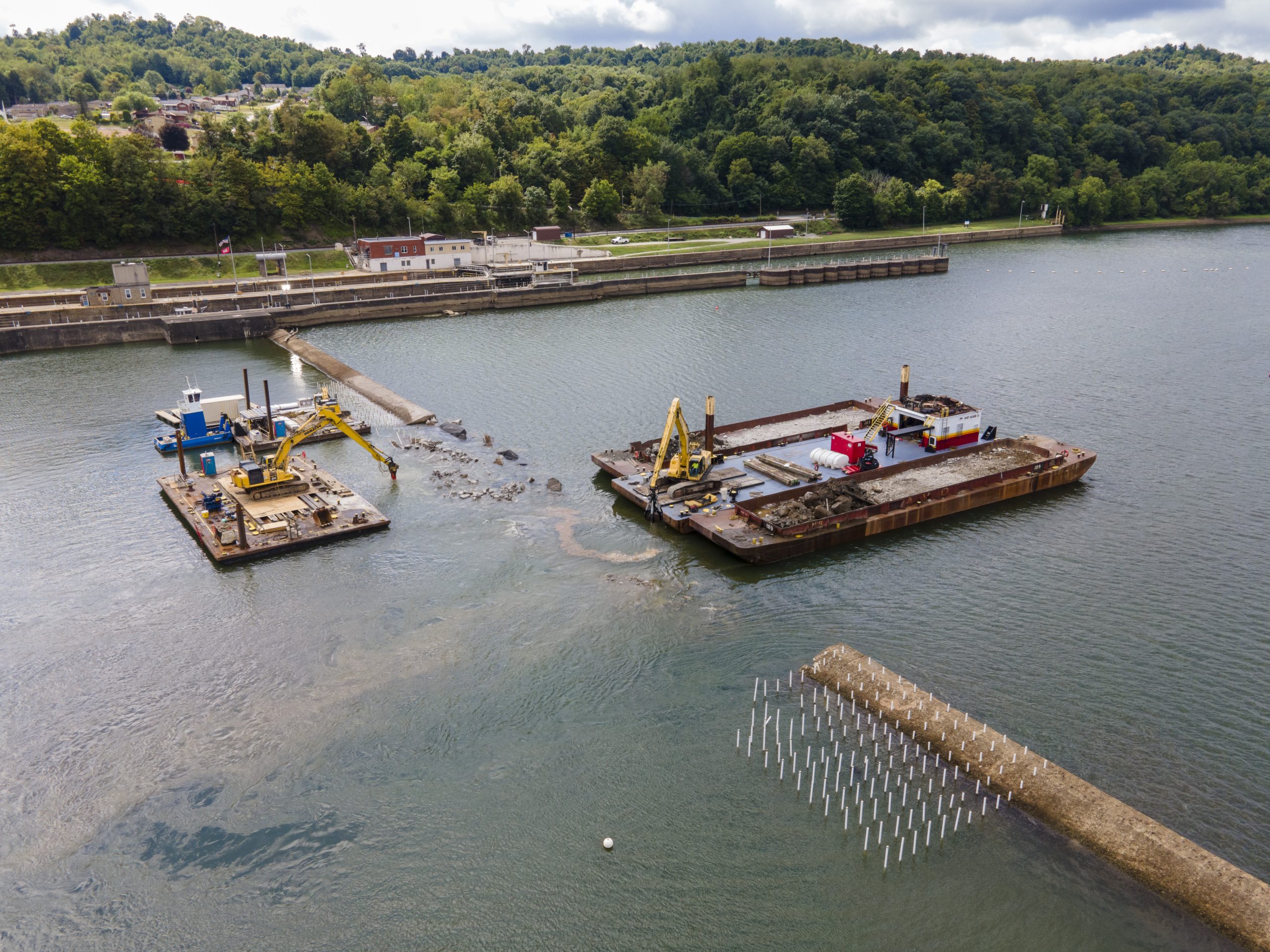While demolition of a former dam on the Monongahela River is complete, work to remove the locks is ongoing, and upstream low-water issues remain.
A 300-foot navigation channel opened in the former Monongahela Locks and Dam 3 at Elizabeth, Pa., commonly known as Elizabeth Locks and Dam, on December 20, marking a major milestone for the project, said Steve Dine, the Pittsburgh Engineer District’s resident engineer for the Lower Mon Project.
“The entire dam is now removed from the bank, the left abutment all the way to the river wall,” Dine said.
Machinery and gates will be removed in the next couple of months, with controlled blasting for wall removal beginning in the spring, he said. Contractor Joseph B. Fay Company began work January 13 to mechanically demolish portions of the lock walls to 2 feet above the water level. Excavators and jackhammers are being used before explosives remove the rest.
Explosive blasts are expected to take place once or twice per week in daytime hours only. A complete river closure 1,500 feet upstream and downstream will be instituted from two hours before to two hours after each blast, with notice of blasting broadcast 24 hours beforehand and on the day of the blast, said Steve Fritz, mega project program manager for Pittsburgh Engineer District.
While the middle and river walls of the locks will be removed to below the river bottom, the wall of the lock adjacent to the riverbank, called the land wall, will remain in place, with a stone berm added for stability of the bank, beneficially using concrete rubble from blasting, Dine said. Fritz added that the abutment from the dam on the opposite side of the river will also stay in place.
Removal of the walls is scheduled for completion by the end of the year, although the full project completion date is set for spring 2027.
Project Background
The Lower Monongahela Project included replacing the fixed-crest dam at Locks and Dam 2 at Braddock, Pa., with a gated dam, constructing a new, larger lock at Locks and Dam 4 at Charleroi, Pa., which was renamed the John P. Murtha Locks and Dam, and, finally, removing Locks and Dam 3 at Elizabeth.
These were the three oldest operating navigation facilities in the country, according to the Corps of Engineers, and they experienced the highest volume of commercial traffic on the Monongahela River Navigation System.
The Lower Mon Project was first approved by Congress as part of the Water Resources Development Act of 1992, with the first construction funding becoming available in 1995.
The Braddock dam was converted into a gated facility in 2004.
A contract that included the middle wall monoliths for the new chamber at Charleroi was awarded in 2015. The chamber is 84 feet wide by 720 feet long and can fit a nine-barge tow of standard barges or six jumbo barges. It was watered in 2023, and officially opened with the facility renamed in 2024.
The contractor breached the dam at Elizabeth, which was built in 1907, the evening of July 10 last year.
Demolishing the dam created one 30.2-mile pool instead of 12.5 and 17.7-mile pools between the locks and dams at Braddock and Charleroi.
Addressing Challenges
Five days after breaching the dam at Elizabeth last summer, on July 15, it was discovered that a miscalculation in lock sill depths presented a potential hazard for commercial vessels. The Corps of Engineers implemented a 7-foot draft restriction through the landside lock, through which traffic was moving, and not the authorized 9-foot draft elsewhere on the river.
When making outflow adjustments to equalize the pools, the Corps discovered a discrepancy in the lock upper sill’s clearance height and river levels based on historical data, Alan Nogy, the district’s operations project manager for the locks and dams branch, said at the time. He attributed the problem to the Corps’ lock system using the North American Vertical Datum of 1929 (NAVD 29) elevation measurements, while the U.S. Geological Survey uses NAVD 88, dating back to 1988 and including different markers for elevation.
As a result, the data shown on the navigation charts and as-built drawings for the 117-year-old lock were 1 foot lower than actual conditions over the upper sill elevation.
While a navigational channel through the breached dam had not been anticipated to open until December, the Pittsburgh Engineer District quickly formulated a plan to open a 100-foot channel to accommodate 9-foot-draft tows more quickly and did so on September 5.
Crews worked a minimum of 14-hour days six days a week to accelerate the channel opening. During critical phases, they worked two shifts, completing 18 to 20 hours of work daily, seven days a week. Dine said challenges included adapting to river conditions and weather conditions. He said close coordination with industry was vital to accomplish breaching the dam and establishing a safe channel, and he added that continues as the Corps of Engineers prepares to remove what remains of the locks.
“Not only do we want to remove it, but we want to remove it safely for all parties involved,” he said.
That work must be done meticulously, he said, especially since most of the structure is underwater.
“You can’t see it with your eyes, so you’re really dependent on divers, and you’re dependent upon surveyors to make sure you’re removing it down to the required elevation.”
Adjusting To Lower Levels Upriver
As a result of river levels that are lower than originally anticipated upstream, the Coast Guard has placed navigational restrictions on tows operating within the pool upstream of the former dam.
While “six packs” of barges in a tow configured two wide by three long are common in this reach of the river, the Coast Guard has restricted those tow configurations to an 8-foot draft, Fritz said. There are no draft restrictions for tows that are only a single barge wide and three barges long.
The reason for the restriction is that, due to the lower water level, the river is narrower in tight bends, especially in upper reaches of the pool, Fritz said. This has created issues where the river was previously wide enough to allow “six pack” tows to navigate around tight bends and pass each other in the straightaways
Fritz said the issues in the river bends were not anticipated either by the Corps of Engineers or the navigation industry prior to breaching the dam.
Mary Ann Bucci, executive director of the Port of Pittsburgh Commission, said that immediately after breaching the dam, tows could draft only 7.5 feet, which amounted to a 25 percent cut in cargo size.
In addition to problems in river bends above the former dam, she said there were issues accessing terminals, marinas and other docks.
Most terminals had permits that only allowed them to dredge 50 feet out from their docks, but the navigation channel was now farther out, Bucci said.
Some of the problem may have resulted from dock owners not realizing the full effects of a drop in the water levels, despite multiple public meetings, Bucci said, but she added that some of the problem was a result of upstream levels settling lower than the Corps had anticipated. An extremely dry summer added to that, she said.
“It’s been that kind of year,” Bucci said. “Everything that could go wrong did.”
Shane Checkan, who serves as general manager of Industry Terminal and Salvage as well as navigation chairman for the Waterways Association of Pittsburgh, said the impacts on industry following the breach had been “severe, not only transiting, but for terminals that were in that pool.”
In places, the water was 1 to 2 feet lower than expected levels in the pool.
“There are a lot of areas on the Mon River where you used to be able to pass where you no longer can,” he said.
Checkan said that while past miscalculations by project developers in the anticipated pool elevations played a role in creating the problems, those mistakes took place years ago, before those overseeing the project were in their current roles.
“The people who are in the positions are doing the best they can,” he said.
Checkan also said Corps officials have been quick to work with the navigation industry.
“I do believe there is a solution, and they’re working as diligently as they possibly can,” he said.
Working Toward Solutions
The Corps has worked with the Waterways Association of Pittsburgh’s navigation committee to determine how best to move forward.
The Port of Pittsburgh Commission was instrumental in obtaining $4.2 million in grant money from the state of Pennsylvania to help terminals dredge out to the main channel from their docks, Bucci said.
Now, she added, the Port of Pittsburgh Commission is working to put out a Request for Qualifications for an engineering group to survey the pool to determine how much dredging is needed and what it will cost to restore the channel to its authorized depth and width.
“This is what Port of Pittsburgh is trying to work out for the benefit of industry,” she said.
Fritz said that, while shoreside commercial facilities are responsible for the cost of dredging their access channels, the Corps is working to expedite permitting and is providing survey information that will be valuable for facilities preparing for dredging.
“We are doing everything we can within our authorities to help make them whole,” he said.
Corps dredging of problem areas within the main channel has helped, too, Checkan said.
“They’re really working right now to get rid of some of the high spots,” he said.
As the Corps continues with the Lower Mon Project, one more contract is scheduled to be let at John P. Murtha Locks and Dam sometime in 2026. It is not expected to have any effect on navigation, Fritz said.
That contract will replace some of the operating equipment still in place from the 1930s to bring it up to a modern standard, he said. The work will make it possible to continue using the landside chamber to lock debris out of the upstream lock approach following high-water events, Fritz said. It can also be used to flush ice from the approach during winter weather.
The contract includes placing struts across the land chamber’s downstream area and adding a stabilization berm to the downstream guidewall. As expected, the landside chamber at the lock is no longer useable for navigation traffic because of the lower water level, with work to recapitalize the landside chamber deferred until the 2050s. Recapitalization will depend on the economic realities that exist at that time, Fritz said. He noted that traffic on the Mon, which once included 15 to 16 million tons of cargo a year, is now only 8 to 10 million tons a year. While coal remains the top commodity on the Mon, it has greatly decreased, he said.
Other remaining work includes a five-year monitoring plan of wetlands along the banks of the Mon and real estate actions, including disposing of easements.
Fritz acknowledged that, although industry is saving costs from having lengthy delays locking tows through at Elizabeth, “They’re not getting the benefits they were expected to get” with the Lower Mon Project so far because of the water level issues.
However, he added, “Utilizing the rivers is still the number one way to move bulk cargo in terms of economic efficiency, environmental benefits and safety.”
Fritz also said it was important to note “huge successes” with the project.
“There’s roughly a 30-mile pool between Braddock and J.P. Murtha Lock and Dam without anybody having to lock,” he said.
Additionally, he said, because of the new dam constructed at Braddock Locks and Dam, the water surface will not fluctuate as it did before construction.
Fritz said, “All of that provides quite a bit of benefit to the region.”
————
Featured photo caption: Contractors for the Pittsburgh Engineer District use floating barges to drill, demolish and remove rubble from the former Monongahela River Locks and Dam 3 in Elizabeth, Pa., on August 2, 2024, creating a 100-foot channel. (Photo by Michel Sauret/Pittsburgh Engineer District)




